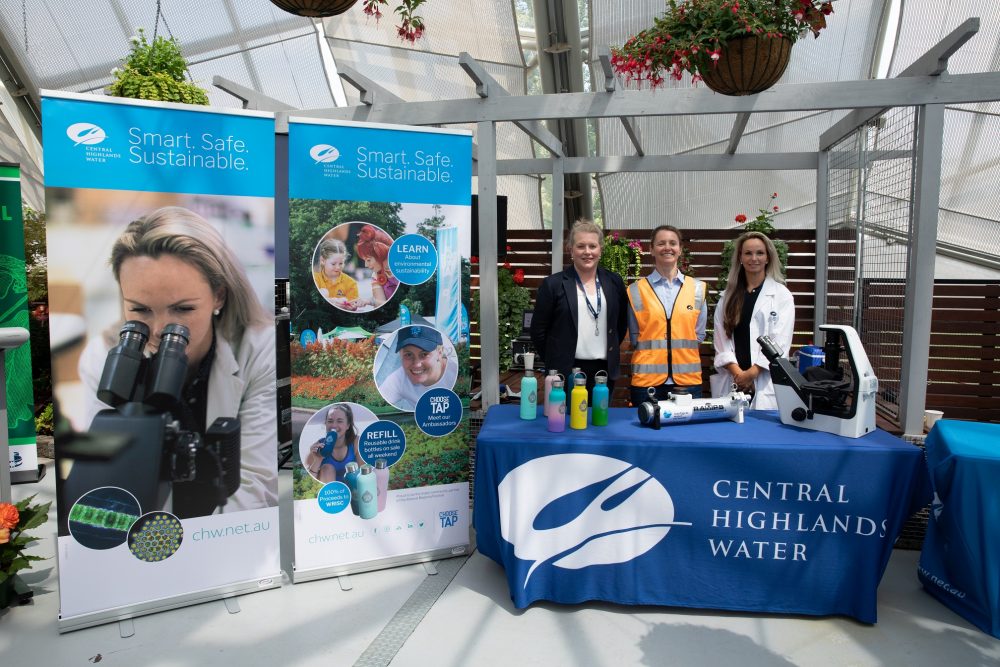Women of science – Women in Business

Central Highlands Water are championing women in science and engineering like Claire Hamersley, Jess Egan and Jenna Cashmore.
How often do we consider what it takes to get water flowing from our taps each day?
WHAT fills our drinking glasses, flows from our showerheads, waters our gardens and flushes our toilets is all part of a much larger water cycle. To deliver safe, clean drinking water requires innovative processes and expertise.
Rain fills our reservoirs, is piped to our treatment plants where it is cleaned and treated before reaching households and businesses. Once it has been used in our kitchens, bathrooms and laundries, water is piped to wastewater treatment plants. Solid rubbish is removed, and the wastewater is treated. This creates biosolids which can be used as fertiliser and recycled water that goes to our green areas and tops up lakes such Lake Wendouree.
Throughout this process, biologists, chemists, engineers and environmental specialists all work to make sure our approach to water is smart, safe and sustainable.
Central Highlands Water employs many women whose career in science, technology, engineering and mathematics, or STEM, means they can deliver quality water to the community every day.
Three women who play integral roles in the water industry throughout the Central Highlands region are Jess Egan, Jenna Cashmore and Claire Hamersley. We’ve asked Jess, Jenna and Claire to share some information about their diverse skills and their impact in innovative and sustainable water delivery.
Jess Egan is a Senior Engineer in the CHW Strategic Asset Management and Planning team. Part of her role is to develop programs to support optimised management of the infrastructure used to deliver water and sewerage services to our region. Jess contributes to reducing costs and disruptions for customers and has been involved in the testing of a prototype robot, known as SAPP2R, which enables safer and more effective sewer maintenance and repair.
Tell us a little about your study and career path?
“I really enjoyed maths and science when I was at school, and often thought up interesting ways of solving problems, so I was drawn to a career in engineering. I have worked in the water industry for around 15 years, with the last three of those at CHW. It’s great to work for an organisation where I can directly contribute to the liveability of my community.”
What is the most exciting project you have worked on?
“When I was employed by Melbourne Water, I was involved in the design phases of a project to upgrade the Upper Yarra Dam. This project comprised installing a filter layer in the upper embankment and installation of a seepage weir downstream of the dam. Given the complexity of construction and the criticality of the reservoir to Melbourne’s water supply system, the coordination of all the different elements made for interesting work.”
What is next for you?
“With technological advancements trending upwards in today’s society, it’s an exciting time to be in this industry. I am keen to embrace new processes and systems to enable smarter, safer and more efficient outcomes. Artificial intelligence and machine learning will continue to become more relevant and widespread, and keeping abreast of innovations will help to deliver more value to our community.”

Jenna Cashmore is a Biologist who specialises in the identification of all different types of algae, including blue-green algae. Through this, she’s able to estimate biovolume and measure the impact of algal levels on water quality or health risks.
What drove you to pursue a career as a biologist?
“I have always had a passion for science and nature. I have experience in different scientific areas, however I love my current biological role as it is challenging and plays an important role in the community.”
At a dinner party, how do you describe what you do to a person sitting next to you?
“I spend endless hours looking down a microscope at the water you drink and possibly swim in. I use distinguishing features and measurements to identify algal species, their potential toxicity, if they are blooming and what effect they may have on safety for both you and your pets, and the effect on water quality such as smell and taste.”
What is your greatest career achievement so far?
“Setting up a biological section from scratch and having it run efficiently and professionally, with some really great feedback, while still being able to work on being an expert in my field.”
Claire Hamersley is an Environment Engagement Officer who has spent all of her career to date in the environmental and agricultural fields including catchment and natural resource management, water quality sampling and environmental management. She oversees CHW’s Environmental Management System, ensuring CHW remains compliant to the International ISO 14001 standard of environmental management.
What makes you passionate about the work you do?
“Water is an integral component of life for people and the environment. We are intrinsically linked to our environment and, as such, the availability of fresh water in the environment underpins the health and wellbeing of the communities that we live and work in. Moving forward in a changing climate, the importance of managing water to ensure its availability in the environment and the provision of clean drinking water to support communities will be a critical factor in overall environmental management.”
If you could teach people one thing about water and the environment, what would it be?
“Water is a finite, but an essential resource. It’s up to everyone to ensure it is used wisely so that our communities and environment can continue to have water available for our requirements into the future.”
Can you share with us an interesting water fact?
“Australia has the highest use of water per person in the world but is the driest inhabited continent. To put this into some perspective, approximately 25,000 gigalitres of water is used by Australia each year which equates to 50 times the volume of Sydney Harbour.”








